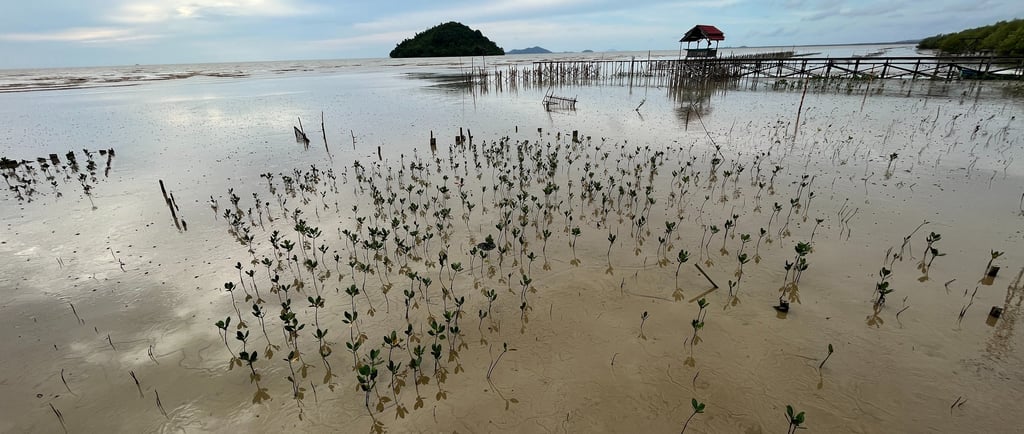Sustainability and Conservation in the Teluk Kramat Peatland Area: Restoration and Protection Efforts in Sambas Regency, West Kalimantan
12/27/20244 min read


Sustainability and Conservation in the Teluk Kramat Peatland Area: Restoration and Protection Efforts in Sambas Regency, West Kalimantan
The Teluk Kramat Peatland is located in Sambas Regency, West Kalimantan, Indonesia. This area spans two districts, namely Teluk Kramat District and Jawai District. Covering thousands of hectares, Teluk Kramat is one of Indonesia's significant peatland areas. In 2007, this area was targeted for an Industrial Forest Plantation (HTI) concession by private entities. However, the plan was met with resistance from local village communities, who were concerned about the potential negative impacts on their farmland, which had long been utilized by the community. Their concerns were not only about the loss of land but also about the potential environmental damage that could threaten their livelihoods.
The Teluk Kramat peatland landscape extends across the villages of Sungai Baru, Berlimang, Lela, and Tri Mandayan, with a total area of 3,229 hectares. Within this area, there are also plantations managed by local communities, particularly for rubber cultivation and various horticultural crops. The Teluk Kramat peatland landscape is part of the Sungai Sambas Besar Payung Peat Hydrological Unit (KHG), with an average peat depth ranging from 3 to 7 meters. This depth makes the area crucial for supporting sustainable peatland ecosystem protection and management.
The communities living around this peatland area have long depended on the land for their livelihoods. The utilization of peatland by the community is still closely related to soil processing and natural resources in the agricultural sector. The majority of the primary income for the communities in the four villages comes from the horticultural plantation sector, fruit crop cultivation, and rubber latex. Farmer groups in several villages with forest management rights have undertaken various initiatives to preserve the peatland, one of which is constructing canal blocks. These canal blocks are vital in keeping the peatland area moist, especially during the dry season. The village communities, both individually and cooperatively, have taken the initiative to build canal blocks on their land. This effort is not only crucial for maintaining the productivity of their agricultural land but also serves as an important step in preventing forest and land fires, which frequently occur in the region.
The Teluk Kramat peatland area is not only important for local communities but also for the biodiversity it harbors. The existence of forests in this area greatly influences biodiversity. Unfortunately, the exploitation of timber resources from 1960 to 2000 resulted in a drastic decline in biodiversity. This decline was further exacerbated by forest and land fires that occurred in 2015 and 2019. These fires had a negative impact on the flora and fauna in the area. A total of 2,000 hectares of forest and land were burned, leading to a significant decrease in species populations and making the area highly vulnerable to future forest and land fires. To support peatland protection and conservation efforts in this area, CAN collaborated with the Sambas Regency Government, the Sambas Forest Management Unit, and local village governments to restore burned peatland areas. This restoration covered a total area of 300 hectares, with a primary focus on peatland ecosystem and biodiversity recovery. In 2022, the restoration team began the first phase of mapping and planting, involving four villages around the peatland area. A total of 50,000 trees were successfully planted on 50 hectares of land as an initial step in the restoration efforts.
In 2024, monitoring of the restored area was conducted, and the results were very encouraging. A total of 93% of the plants successfully grew and thrived, with creeping plants covering nearly the entire area. This success indicates that the restoration activities have been effective, and natural succession processes are supporting plant growth. This success has also inspired a greater commitment to fully restore the planned area, involving more local communities in the process. One key factor in the success of this planting was the canal blocking that had been done previously. Therefore, CAN supports the construction of five additional canal blocks to continue reducing the risk of peatland drying and fire hazards that could threaten the sustainability of the ecosystem in the area. In addition to restoration activities, CAN is also actively involved in efforts to protect the remaining peat forest in the Teluk Kramat area. Active patrols are conducted in collaboration with peatland conservation community groups to ensure the preservation of the remaining peat forest. Within this forest, there are habitats for important species such as the sun bear, pangolin, sambar deer, mouse deer, red langur, and several other small primates. These protection efforts are crucial given the high threat of forest and land fires, as well as the pressures from human activities that could damage the peat forest ecosystem.
The success of restoration and protection efforts in the Teluk Kramat peatland area cannot be separated from the active participation of local communities. Awareness of the importance of preserving peatlands has encouraged communities to become directly involved in various conservation activities. From canal blocking, forest patrols, to replanting burned land, all are done with a spirit of cooperation. This community participation serves as an example of how local initiatives can have a significant positive impact on environmental conservation efforts. Looking ahead, the challenges of preserving the Teluk Kramat peatland area remain considerable. However, with good cooperation between the government, communities, and organizations like CAN, there is great hope that this area can continue to be protected and managed well. Protecting peatlands is not only important for preserving biodiversity but also for supporting the well-being of communities that depend on this land. The restoration efforts that have been carried out demonstrate that positive change can be achieved through hard work and collective commitment. The Teluk Kramat peatland not only stands as a successful example of peatland ecosystem restoration in Indonesia but also as a symbol of the importance of collaboration between various parties in protecting and preserving the environment.